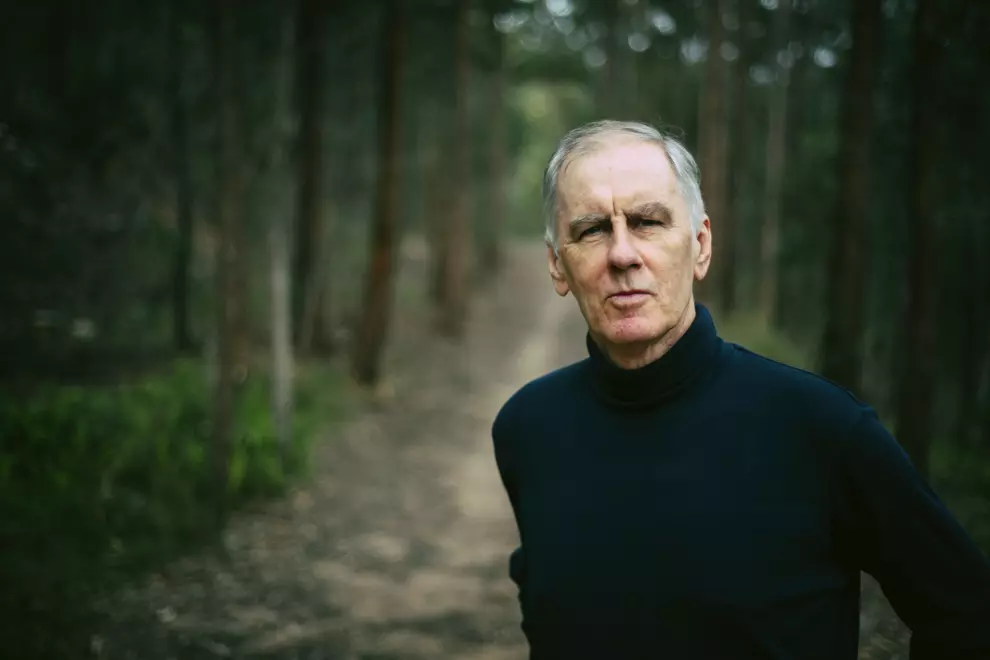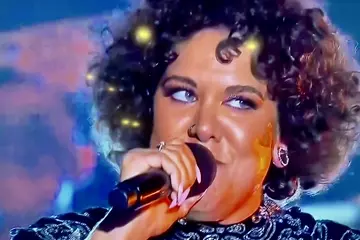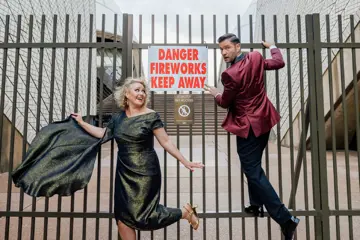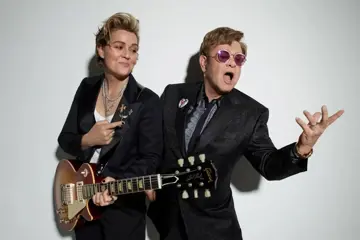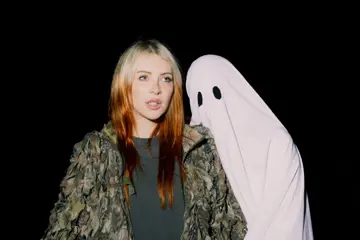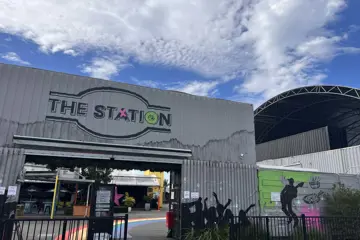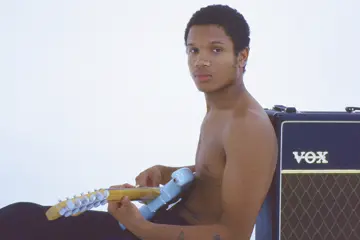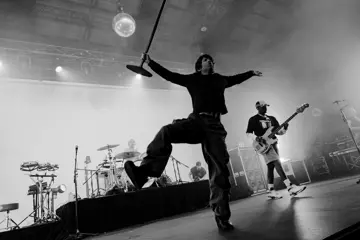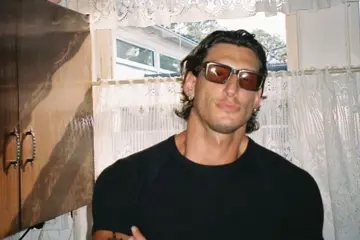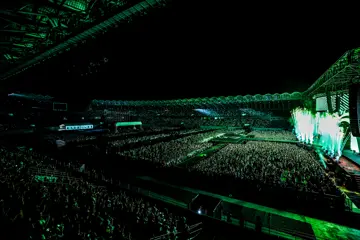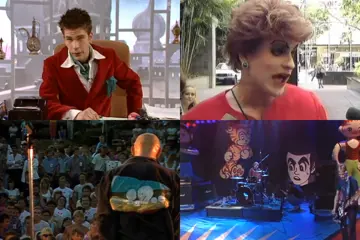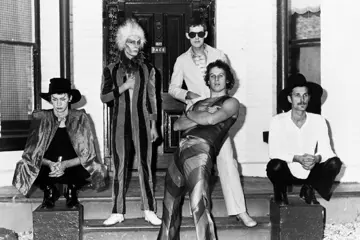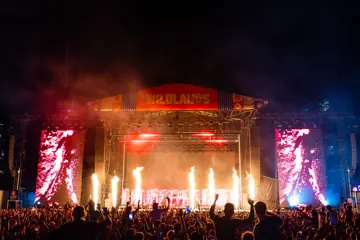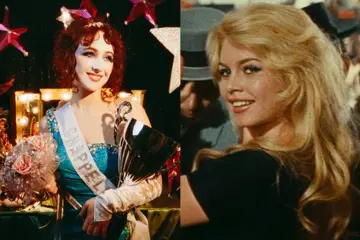 Robert Forster
Robert ForsterIconic Brisbane singer-songwriter Robert Forster has been involved in putting together many, many albums over his storied career - releasing nine long-players with his beloved band The Go-Betweens and now eight in his equally-excellent solo canon - and while it hasn’t always been smooth sailing, until now none of those records have arrived hewn from pure adversity like his latest effort, The Candle & The Flame.
It’s a resolutely gorgeous collection of songs - intimate and intensely personal - yet its genesis sadly lies in personal heartbreak. Back in 2021 Forster’s wife and long-term musical companion Karin Bäumler was diagnosed with ovarian cancer, and life as he knew it was put on hold and his priorities recalibrated.
Naturally, his entire focus became being present for his partner and as supportive as possible in the dire circumstances. His music initially became an entirely secondary concern as they embarked down the road of treatment and recovery, until - slowly but surely - it crept back into the frame. Only this time rather than to further Forster’s career the ambition was to summon art’s healing power, to harness the innate restorative powers of the form.
In a time of such tumult and uncertainty music became a bedrock and means to ward off the inherent post-diagnosis fears, with other family and friends organically rallying together as the project progressed in dribs and drabs when health and circumstances allowed. The final product The Candle & The Flame is an extraordinary album and undoubtedly one of Forster’s finest, but this time around it almost seems as if the journey was as important as the destination.
Don't miss a beat with our FREE daily newsletter
“Yes, that’s a very good way of putting it,” the singer nods. “Of course when we started the journey we didn’t know that we’d be able to finish the record. In fact at the very start of the journey when Karin first got her diagnosis there was no intention of even making a record, that just happened gradually. Everything sort of just bloomed out in a way, without any sort of master plan.
“We got to finish the record, we’ve got to make videos, we’ve watched it all the way through to this moment. Even just tracking how it’s been going and talking about the artwork for the album, and talking about the mixes, it’s all been part of the one thing. It’s given us great… entertainment, almost - something to do besides dealing with the seriousness of Karin’s situation - so it’s provided something to us all the way along the line."
With the couple originally playing music together in their home as a form of escape, it didn’t take long for the impromptu sessions to take on a life of their own. First, they were joined on guitar by their son Louis (frontman for sadly-defunct Brisbane rockers The Goon Sax), then later by Forster’s former Go-Betweens bandmate Adele Pickvance on the four-string.
“Karin and I are obviously living in the house together so we started playing together almost as therapy, not intending to make an album,” he recalls. “Then Louis had put off a tour with The Goon Sax in Europe - he found out about the diagnosis just before he was about to fly off - so he was here and he started dropping in and joining in the playing, although he was here visiting his mother all the time anyway.
“But he brought a guitar over and started playing on the songs, and then Adele visited bringing over food - a group of our very kind Brisbane friends started up a cooking group because we were just overwhelmed - so I asked her to bring over her bass and a little amp one day, so she did and she joined Louis, Karin and I.
“It was early in Karin’s diagnosis and we were just strumming songs here - her and I, then her and I and Louis and then Adele - but immediately your mind forgets the current situation and you just go to another reality. So that was just the beauty of music, and it was enormously helpful to us in those months.
“And we did this one seven-hour recording session before Karin was going in to have a big medical procedure, just to document what we’d been doing. Then we heard I Don’t Do Drugs I Do Time and we heard It’s Only Poison, and we thought that they sounded complete. Somehow we’d fluked this thing, and this was the key to the realisation that after the operation - after Karin gets better - we can think about doing more recordings in that manner.”
The moving clip to the album’s lead single She’s A Fighter - directed by Brisbane film-maker Denny Ryan - gives a good sense of the familial and musical camaraderie forged during the sessions, with the proud parents joined not only by Louis but also their daughter Loretta, the entire family seated and facing each other as they perform the poignant number together.
“It was an amazing moment,” Forster marvels of the clip. “We knew it, we could sense it. Because on a number of levels our family has never been something that we’ve wanted to feature in the limelight with us in any way. And also Louis has got his own thing going with music, and he wanted that space and we were very happy to give it to him that space.
“That’s it on one level, the other level is that here we are as a family playing music. Here we are almost a year after the diagnosis being filmed playing this song - we just knew the power of that, and the power of us doing it as a family. And we already knew the power of the song."
She’s A Fighter contains only six words - “She’s a fighter, fighting for good” - yet still manages to convey an incredible amount of emotion amidst the brevity.
"Six words! It’s occurred to me recently that even the Ramones can’t do that!” Forster smiles. “They needed 12 words - I’ve halved the Ramones! That was the only lyric that I wrote after the diagnosis - that was the only new thing. All of the other text for the songs was written beforehand”.
One of the most surreal aspects of The Candle & The Flame is that the bulk of the album’s songs pre-dated the health scare, given that all of them seem as if written specifically in light of that predicament.
“That’s the amazing thing - it stuns me and it stuns Karin, and I just don’t know how that happened,” Forster marvels. “I was thinking this the other day, I’m just sort of really happy that I had all the songs finished. I could have had half-songs and half-lyrics and I wouldn't have been able to write a word. I wouldn’t have been able to add to any of them because it would just be too heavy and too overwhelming, and I didn’t have the time to do it anyway.
“But they were all written, including the music for She’s A Fighter, and then just seeing Karin respond to the news of her diagnosis and what she had to do - the fight she was going to take to it - inspired those six words. So in a way, I was lucky that they were all complete."
Forster admits that these pre-existing songs - which he’d been hoarding with a new album in mind - didn’t need to bend much to suit this new scenario.
“Not really, I write on the acoustic guitar so it’s not like I’ve got a laptop and I’m doing blips and blobs and it’s all quite piecemeal - I’m a traditional singer-songwriter on a guitar,” he tells. “I was thinking that I’d make an album in 2023, but I didn’t know where.
“Maybe if I had the budget I was thinking about going back to Berlin and working with Victor Van Vugt again - that’s if I had the money - but I wasn’t thinking about doing them in this form. But as I said, being a singer-songwriter you can mould them quite easily - you don’t need ten people there doing bits and pieces, they just come straight from the guitar and people can join it.”
The fact that the songs were recorded live works superbly in terms of catching the spontaneity of each take, but the singer explains that this was by necessity rather than design.
“It was necessary,” he offers. “When a normal album’s made - and I’m just doing an average calculation here - you rehearse in the studio for three or four weeks and then you’re in the recording studio - if you can afford it, otherwise in the home studio - for three or four weeks, or three or four months. None of that was going to work: with Karin in chemotherapy, none of that was going to work.
“It just had to be a day here and a day there. We had to rehearse at home, and then we went in and set up in Alchemix studio in West End in a circle just like the She’s A Fighter clip, so when you see the video we recorded a lot of the album like that - there are overdubs and there’s a drum-kit on a couple of songs, but that’s the way we did it - so the circumstances created the sound in a way.”
Forster has written a lot of autobiographical songs over the journey, but this batch seems markedly personal and vulnerable in a way he’s rarely explored before.
“It was, it was” he ponders. “I’ve written a lot of songs from that angle before - songs like German Farmhouse and Here Comes The City and Born To A Family, all of those songs - but this was probably a little bit more pointed, a bit more direct.
“This time around I wrote Tender Years really early, and that was clearly autobiographical, and that kind of set the tone for what followed. Probably writing Tender Years led me to When I Was A Young Man, which is also autobiographical. Then that led into I Don’t Do Drugs…, and it just kept on going in that vein."
When I Was A Young Man is one of the album’s unabashed highlights - recounting Forster’s initial forays as a songwriter - tucked away as the final track to finish the record on a high.
“It’s such a great song, that’s why we put it last,” he admits. “It’s kind of a little bit outside the story and also inside the story, so it works going last. It’s one of the best songs I’ve ever written, it’s a real favourite of mine and one I’m very proud of."
A rudimentary knowledge of The Go-Betweens story places When I Was A Young Man in the inner-west Brisbane suburb of Toowong in roughly 1978, a time when Forster and his uni friend Grant McLennan - who he formed the band with around this time, and made music with until McLennan’s sad passing in 2006 - were both discovering their latent creative potential.
“Yes, all of that stuff about living in 'the house down the lane', and 'it was so beautiful, there the times were insane' that was all Golding St in Toowong and the [record store] Toowong Music Centre - that’s where I was when I was 21,” he recounts. “It was about moving out of home, moving to Toowong, still going to university part-time, Grant and I starting the band and hanging around Toowong Music Centre - golden times. Golden, golden, golden times."
The world must have seemed like an open book of possibilities to explore for Forster as his talents unfurled.
“Well, I knew it was going to be tough and I probably thought that I had to move out of Brisbane, and that was daunting,” he continues. “But the really big change was starting to work with Grant. One person trying to do all of that would have been impossible, and it would have been overwhelming for me - I don’t think I could have done it.
“But once there was the two of us, we backed each other up and then it felt like anything’s possible. That was the moment - Grant was really a steadying influence but also a total dreamer, yet he was also really driven - so once the two of us got going, and that’s all in that song too, things felt possible."
There must have been a slight ‘fish out of water’ aspect at the time as well, given that both Forster and McLennan were enamoured by foreign film and literature which gave them an almost bohemian vibe compared to the average late-‘70s Queenslander.
“Yeah there was, but we were also very supported,” he tells. “We could get shows. [Community radio station] Triple Z were playing us, people were interested in what we were doing, and we were friends with other bands like The Riptides and Xero and The Apartments - it was a pretty friendly scene.
“We were obviously different, but everyone was different to an extent to anybody else. But obviously, Grant and I weren’t walking around - like quite a few people were - in leather trousers and chains and things like that, we weren’t into that which probably set us apart to an extent, but it all worked out.
The Go-Betweens’ classic Spring Rain - penned by Foster for their fourth album Liberty Belle And The Black Diamond Express - also explored Forster’s formative years in Brisbane through a similarly wistful lens.
“They are in the same era, although Spring Rain was a little bit earlier than When I Was A Young Man which is about when I was 21, in Spring Rain I was about 17 or 18,” he remembers. “But those years - particularly for me, but for everyone - when you’re about to leave school to when you’re about 21, are so formative and so much in my mind, that I just have to go there or think about it and images and ideas come to me. It’s such an informative time in your life, but it’s also so rich for songwriting or any kind of memoir - so many books have been written about people in that age-group, and so many great films."
Another highlight of the new collection is The Roads, in which Forster recounts travelling in the car alongside Bäumler on trips around her homeland, seemingly as much about the couple sharing that particular solitude as it is the actual infrastructure.
“It is, it is,” he agrees. “But they’re real roads. That song I wrote the melody in Bavaria in Karin’s family house, and I made a spontaneous decision to write the lyrics about Bavaria and my time there and just driving around in the car with Karin - she always drives in Germany, and I do more of the driving in Australia. So it’s just a passenger seat view of looking out at Bavarian countryside, and these little roads that take you places but also disappear and go off and lead to people’s houses or old churches and end in forests, or disappear into forests and you wonder where they go.
Another powerful track There’s A Reason To Live reflects on how you can find meaning in the strangest of places.
“You do, and sometimes it’s the everyday things,” he says. “That to me is very much a COVID song, remembering to an extent how easy things used to be. It’s all in that line “it’s not profound, it’s what I found” - about how it’s just these things that are at my fingerprints or in my hands that aren’t profound but in a way are. And when you’re looking for reasons to live, it’s all around you - those reasons to go on are touchable.”
The “non-profound” item in that particular track was an old gig ticket found in a jacket pocket, and while the songwriter admits that the song is based on real-life events a bit of creative licence was involved.
“I’ll let you in on a secret - the ticket was actually a dry-cleaning ticket,” he chuckles. “I was in Sweden and I was doing a tour with these wonderful Swedish musicians, and we were rehearsing in Stockholm where they all lived and I went to a dry-cleaners to get some of my clothes cleaned because I’d been on the road a bit.
“This lady at the washing centre gave me this little pink ticket - it was how they did it, like something from the 1960s - and I must have put this little ticket in my suit jacket. Then a couple of years later in 2020 when I was writing the song I reached into my jacket and pulled out that Stockholm dry-cleaning ticket, and I must have written the lyrics soon after and just changed the ticket to a gig ticket.
“It’s the same concept, I pulled out the ticket and looked at it - and it’s all in Swedish but I remembered the dry-cleaning place and the lady - I must have changed it to something a little bit more relatable. But isn’t it fantastic that those things are just there - lingering in a pocket - and when you find them you just race back in time."
As is the cyclical way of the world for musicians, Forster is about to embark on a run of live shows to promote his new opus.
“I’m doing a short tour of the UK and Europe - it’s only three weeks because I don’t want to be away too long - and then I’m doing a big Australian tour in May as well,” he explains. “I’m really excited to play these new songs - I want to play as many as I can - and I’m working on a setlist now.
“If I do six or seven songs from the new album then the other songs I choose have to sit with them, and looking at the setlist I was surprised - though I shouldn’t really be surprised - about how these new songs shape that, shape what other songs will be around them.
“Honestly, these days I could play for three-and-a-half hours and I’d be happy and I’d be playing what I thought were my best songs. I’m not slapping myself on the back, but it really is now more about what I leave out. But I play different songs throughout the tours, and different tours have a different emphasis.”
It’s wonderful that even after all these years Forster still loves playing his compositions in the flesh and revelling in that connection with his devoted fans.
“Oh definitely, to me it’s almost what it’s all about,” he stresses. “Being able to stand onstage and do that - play song after song to a crowd that’s attentive - weaves something over an hour-and-a-half to an hour-and-forty-five-minutes that’s really powerful, I love it”.
Aside from this album-related chicanery Forster has a lot on his plate for 2023: following a couple of well-received literary forays (including his exceptional 2016 memoirs Grant & I) he’s working on his debut novel, as well as working on the third (and final) instalment of the epic G Stands For Go-Betweens boxset series, although of course his priority is helping Bäumler on her long road to recovery.
And, while she’s still far from out of the woods, Forster shares some exceedingly positive news in that regard.
“She’s doing well,” he beams. “She’s getting stronger and she’s travelling well. It’s good.”
ROBERT FORSTER
THE CANDLE AND THE FLAME AUSTRALIAN TOUR
Friday May 12 - Trinity Sessions, Adelaide
Saturday May 13 - Venue: Freo Social, Fremantle
Thursday May 18 - Venue: Theatre Royal, Castlemaine
Friday May 19 - Venue: Brunswick Ballroom, Brunswick
Saturday May 20 - Venue: Memo Music Hall, St Kilda
Sunday May 21 - Venue: Archies Creek Hotel, Archies Creek
Friday May 26 - Venue: Princess Theatre, Brisbane
Saturday May 27 - Venue: Factory Theatre, Sydney
Sunday May 28 - Venue: Lizottes, Newcastle

